How to Know if a Wild Animal Needs Help
Not every wild animal that appears alone or still needs to be rescued. Please consider the following before intervening:
How to Know if a Wild Animal Needs Help
Not every wild animal that appears alone or still needs to be rescued. Please consider the following before intervening:
If you’re unsure, contact us for advice before moving or handling the animal.
1. Keep the animal in a secure, dark container.
2. Keep the container in a warm (80 – 90 degrees) and draft-free place. If the animal is very young (i.e., is incompletely feathered or hairless, or has its eyes still closed), place a heating pad set to low underneath the container. If the animal is older, place only half of the container on the heating pad – this will allow the animal to choose its ideal temperature.
3. Stay calm and quiet around the animal, and don’t disturb it. A quiet, non-invasive environment will reduce the stress on the animal and give it a better chance to survive. Avoid peeking in on it repeatedly.
4. DO NOT feed the animal or give it fluids.
5. Take the animal to a qualified rehabilitator as quickly as possible. Rehabilitators are specially trained to care for sick, injured, and orphaned wildlife, and the animal’s best chance of success is with a rehabilitator. Never keep the animal or try to treat it yourself – wild animals should never be kept as pets.
OPEN EVERY DAY, 365 DAYS A YEAR
DO NOT handle wildlife without heavy gloves.
Even tiny animals can inflict serious and painful bites and scratches.
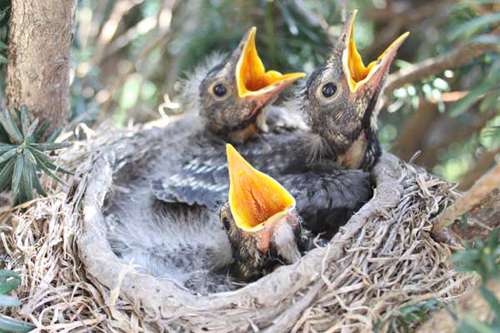
Read the descriptions below to help you determine if the animal needs help.
FEATHERLESS/NEWLY HATCHED (HATCHLING) BIRDS

If the bird is not injured, locate the nest and place the young one back in it. Birds are unable to detect your scent on their young and after you leave they will quickly forget your intrusion. Be sure to place the bird in the correct nest (as parents may toss out unfamiliar babies). If the hatchlings are injured, have had contact with a cat or dog, one/both of the parents have been confirmed missing, and/or you cannot place the young bird back in the nest, call a wildlife rehabilitator immediately. If they are cold, warm them in your hands, then place in a small covered box on a heating pad set to low. DO NOT feed or give water.
DOWNY/INCOMPLETELY FEATHERED (NESTLING) BIRDS
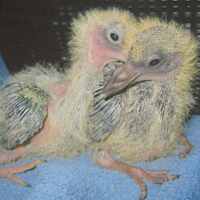
These are older birds, not quite ready to fly. Find the nest and place the young back in it, unless the bird is injured. Songbird parents cannot detect your scent and will continue to feed and care for their young once you return them to the nest.
If you are unable to find the nest, cannot place the young in the nest, it is injured or has had contact with a cat or dog, the bird should be taken to a rehabilitator as soon as possible.
If the bird is replaced in the nest and the parent does not return, the bird should be taken to a rehabilitator.
FULLY FEATHERED (FLEDGLINGS) BIRDS

These birds are completely feathered, can hop about, and may be able to flutter or fly short distances. Leave them alone unless they are being attacked by a dog or cat.
This stage of life is a natural part of a bird’s training and development. The parents keep track of their young, protect them, and feed them. They should be left on the ground (to be fed and protected by their parents) unless they are injured or in imminent danger.
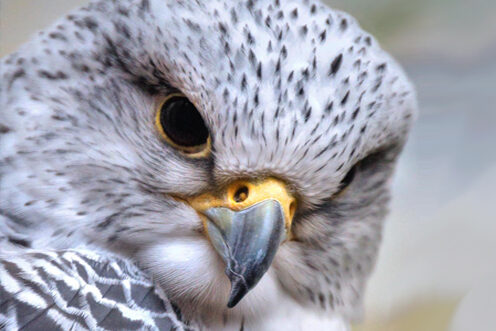
We provide care for injured raptors.
In addition, you can also contact the below raptor rescue facilities:

DO NOT touch bats with your bare hands. Bats may bite when they are stressed or afraid and can carry diseases that are transmissible to humans through bites. Contact a bat rehabilitator before attempting to capture or remove a bat.

During the first two weeks of life, fawns are often left alone by their mothers. The mother returns every few hours to nurse.
Fawns who are found curled up and quiet should be left alone. Only interfere if they are standing and crying, and appear very weak or injured.
Contact a fawn rehabilitator for advice before attempting to rescue a fawn.
Contact your local animal control or fish and game.
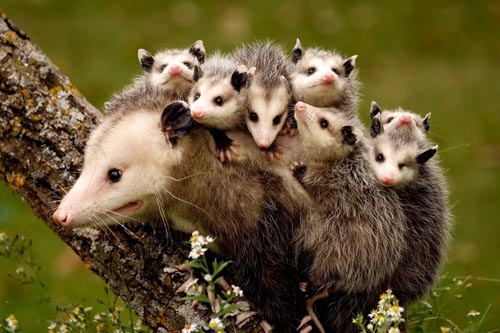
Baby opossums stay in their mother’s pouch for about ten weeks. When they emerge from the pouch, the tiny youngsters are often seen accompanying their mothers on nocturnal foraging expeditions.
If an opossum is six to eight inches long (not including the tail), it is independent of the mother and should be left alone. Smaller opossums found wandering alone, or injured opossums should be taken to a rehabilitator.

Rabbit nests are shallow indents or burrows in the ground. If you find a rabbit nest, leave it undisturbed and protect it from pets until the babies leave, usually after 3 – 4 weeks. If you accidentally disturb a rabbit nest, cover it with dry grass.
Rabbit mothers will continue to care for their young even if they have been handled or if the nest has been exposed by a lawnmower. Rabbits are crepuscular (they are more active at dawn and dusk), so you may not see the mother rabbit entering and leaving the nest.
Bring young rabbits to a rehabilitator only if the mother is confirmed dead or missing, the infant is injured, or the nest has been completely destroyed.
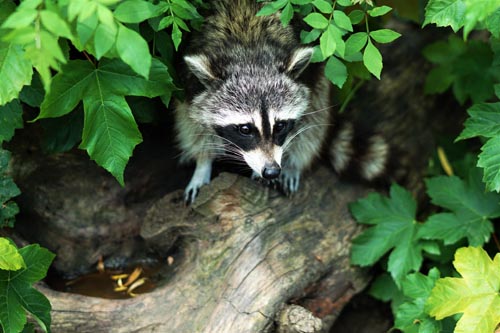
Young raccoons are frequently left alone by their mothers for several hours at a time, at dusk or during the night.
Bring young raccoons to a rehabilitator only if the mother is confirmed dead, the infant is injured, or the mother has not returned by late morning and the babies are making loud noises.
DO NOT touch raccoons with your bare hands – heavy duty gloves are recommended. Raccoons may scratch and bite when they are stressed or afraid and can carry diseases that are transmissible to humans through bites.
All snakes are beneficial – they help to control pest populations, and they serve as prey for many raptors. If you find snakes on your property, it’s best to leave them alone. If you wish to remove them, remove sources of shelter such as debris piles and brush, and rodent food sources.
If you encounter a snake, don’t panic! Snakes are as afraid of humans as we are of them, and given the opportunity, most will simply leave the area.
At first glance, a Rattlesnake and a Gopher Snake look similar but you can learn to tell them apart!
Gopher snakes (shown at left) are non-venomous. If you cross paths with a gopher snake, it will most likely imitate a rattlesnake by flattening its head, hissing, and shaking its tail rapidly. Gopher snakes can be identified by the narrow head, thick neck, and squarish black markings, and their long and skinny tail has no rattle.
Northern Pacific Rattlesnakes are the only venomous reptile in the Sacramento area. These can be identified by their large diamond-shaped heads and the presence of a rattle on the tip of the tail. If you are not sure whether you have found a rattlesnake, do not attempt to capture or handle the snake yourself. Contact a wildlife rehabilitator before attempting to capture or remove the snake yourself